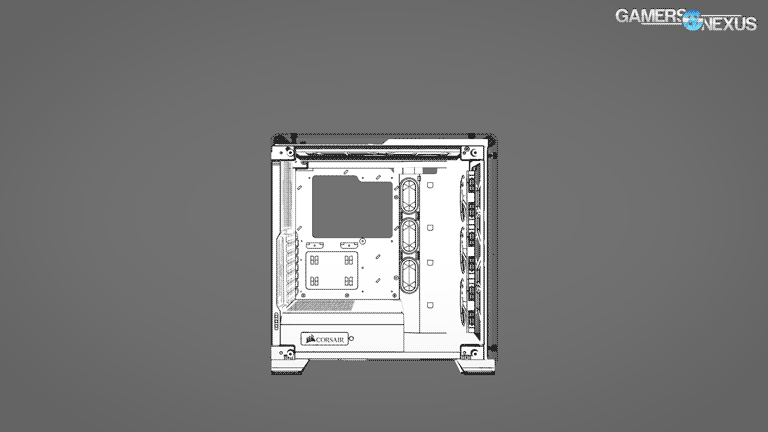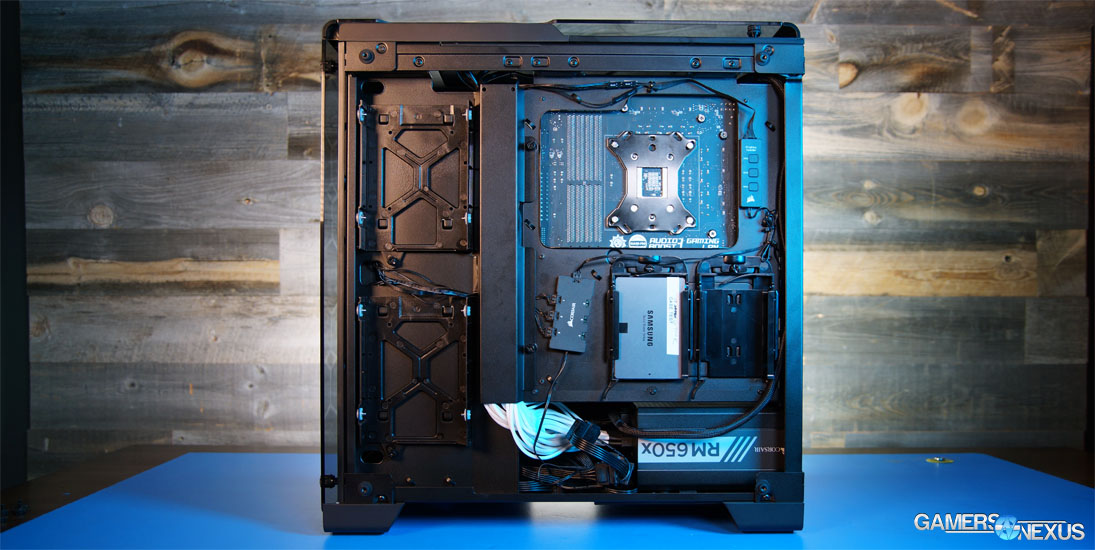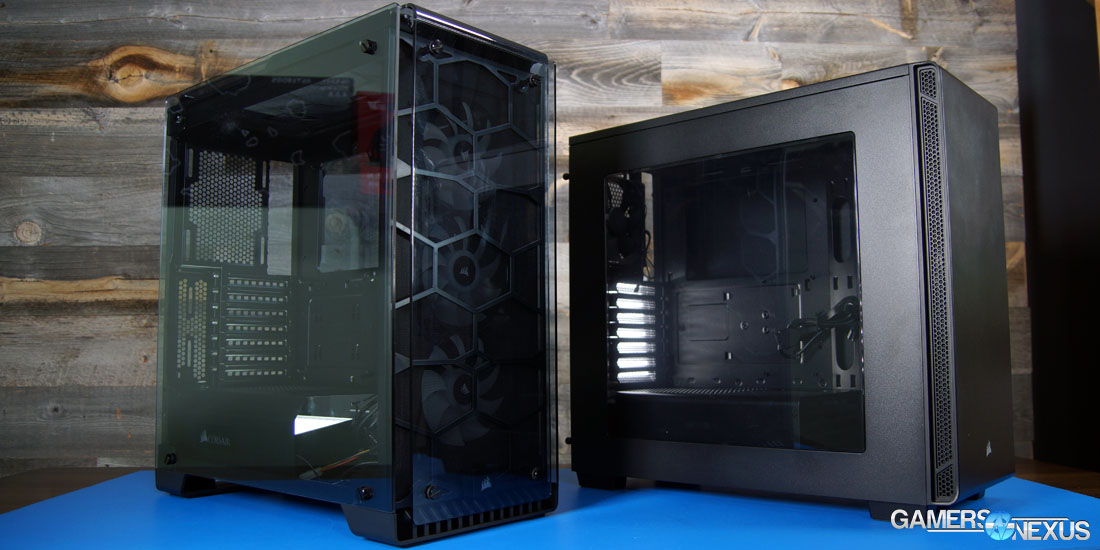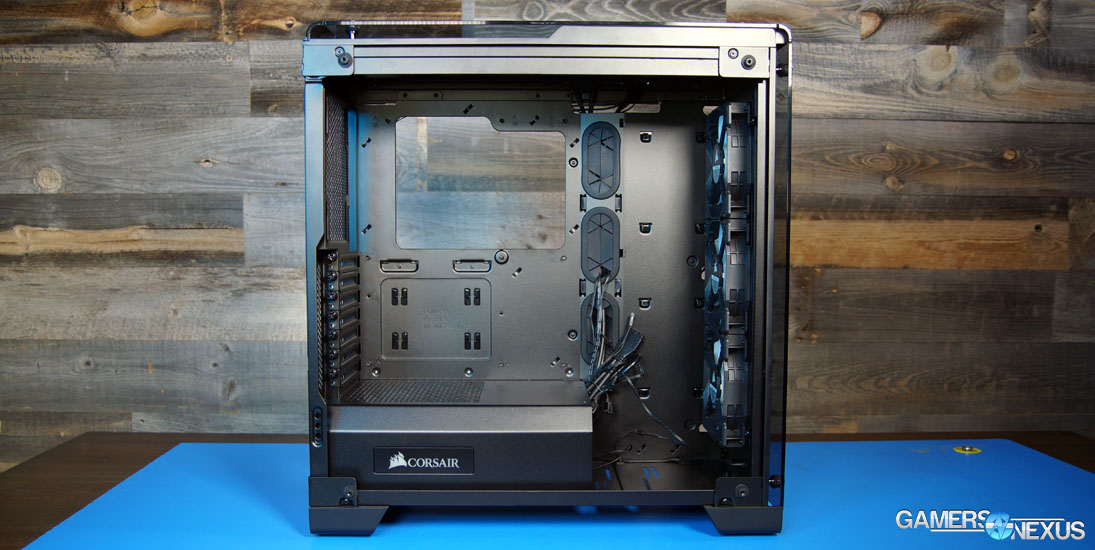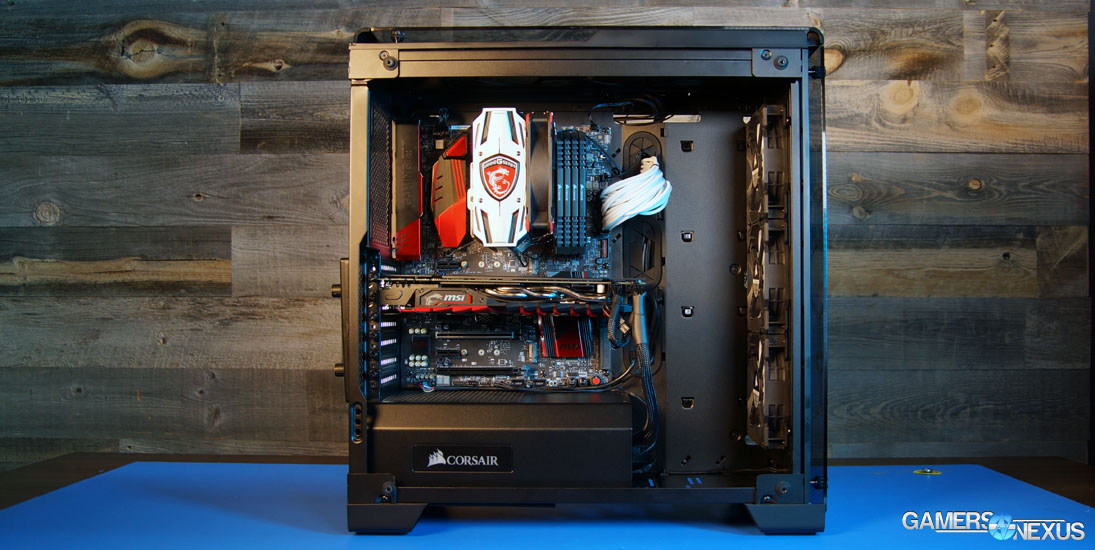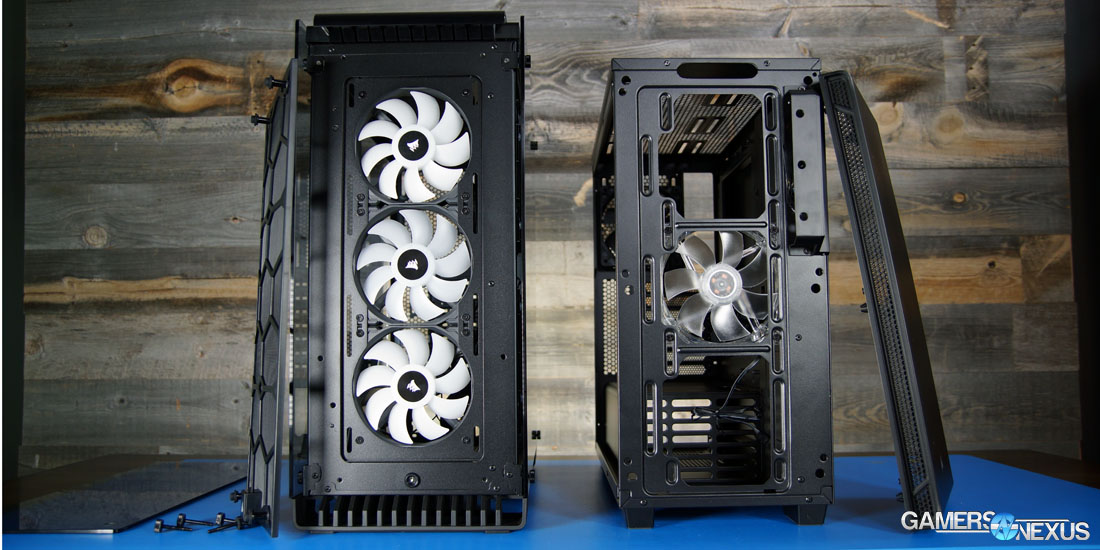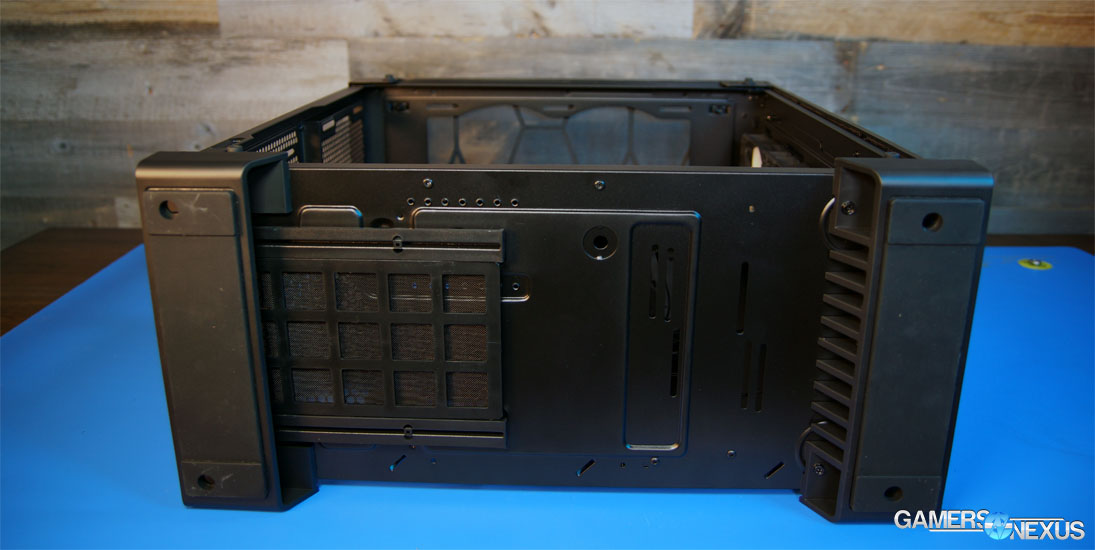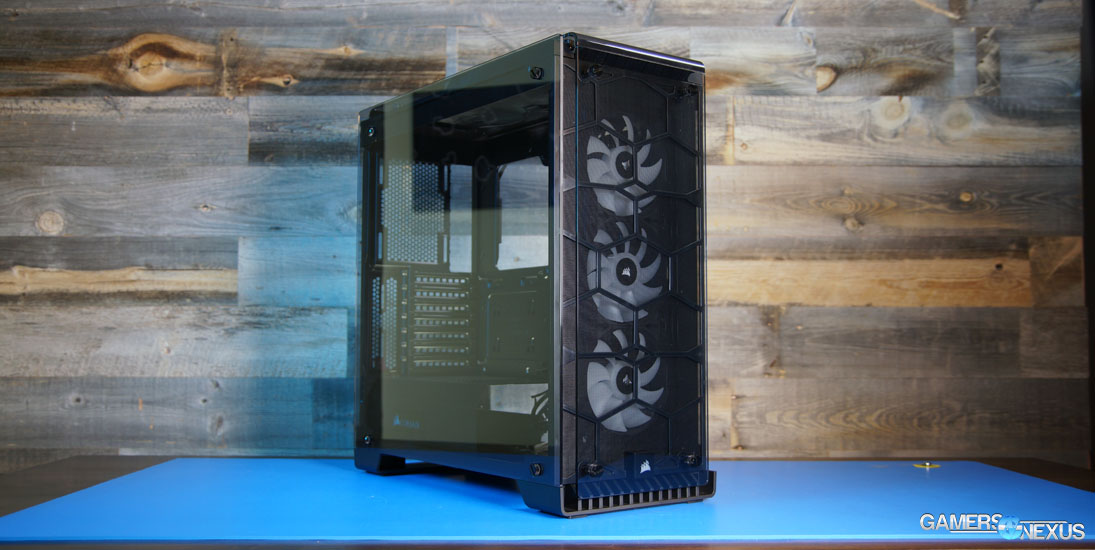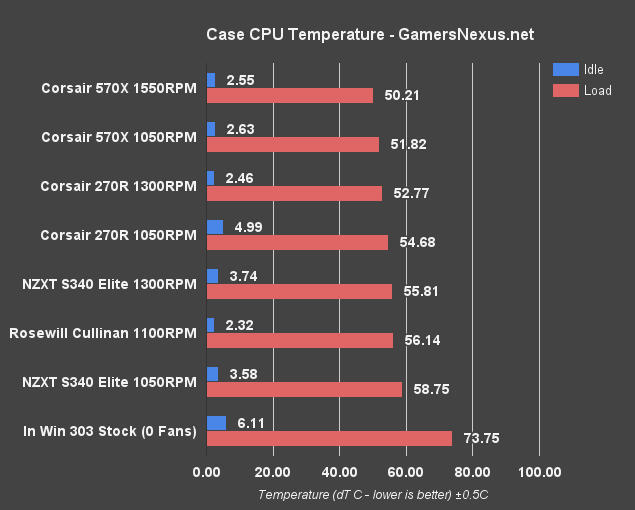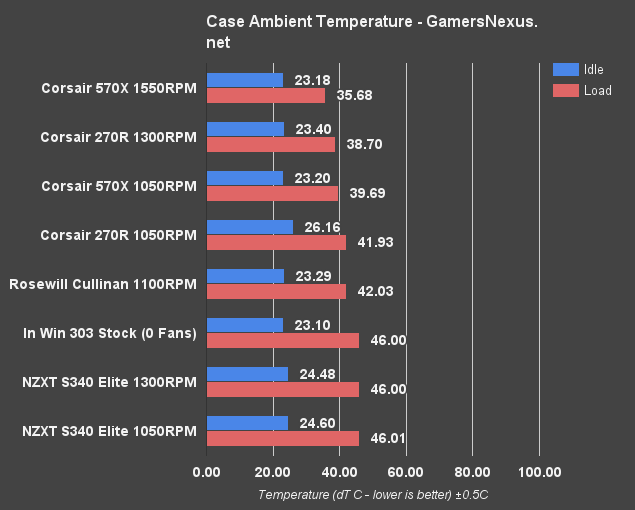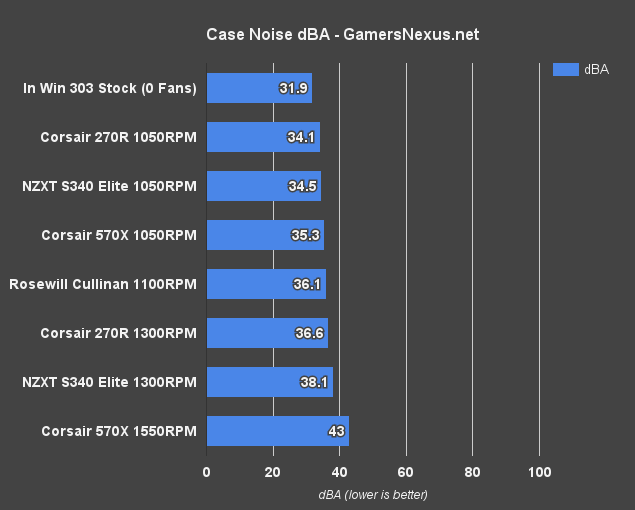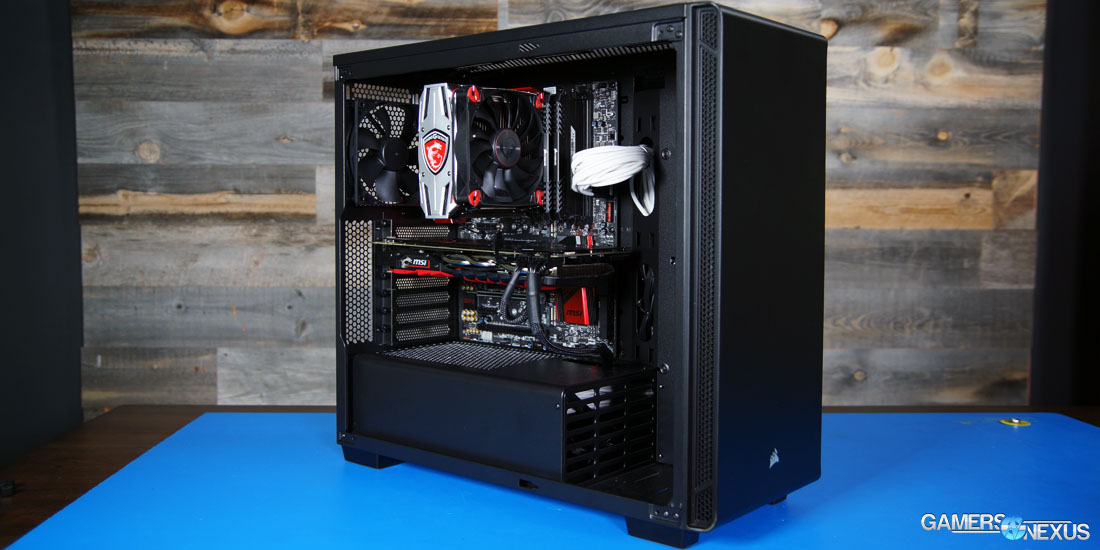Corsair today launched two new cases: The Corsair 570X RGB case, which uses tempered glass on three sides and costs $180, and the Corsair 270R, a $60-$70 budget-oriented solution to the S340 problem. The product page for the 570X is here (Newegg), and the 270R is here (Newegg).
Both cases are in for review. This Corsair 570X and 270R case review demonstrates thermal performance for both enclosures, including CPU, GPU, and case ambient thermals, and noise (dBA) testing versus nearby competitors. The S340 Elite, Rosewill Cullinan, and In Win 303 are included against the new Corsair products. We're building-out this new test bench and still need to add the 400C, 600C, N450, and a few SilverStone/Be Quiet cases.
The 570X was preempted by Corsair's 460X ($140)—yet another tempered glass and RGB enclosure—released just after PAX Prime. The 460X was preempted by the Computex announcement and later launch of the Be Quiet! Dark Base 900 and Rosewill Cullinan (which we reviewed here vs. the Anidees Crystal -- the same case, both by OEM Jonsbo).
All of these cases use tempered glass. That's the theme we predicted back in June, and it seems to have been dead-on. It's all RGB, all glass, all day for 2016 case design. The previous trend was PSU shrouds, and we can't say that wasn't a welcomed change of pace for an industry that had otherwise stagnated. Cases are alive and well this year, it's just a matter of figuring out whose alphabet soup of features is worthwhile and worth the spend.
The video review is below, but the article -- as always -- is published in its entirety in the following pages. If you normally favor the articles, note that we've got a custom animation in this one that's worth a view. It pops-up within the first few minutes, and shows an explosion of the 570X and its tooled components.
Corsair 570X & 270R Video Review & Component Explosion Animation
Above: In this custom animation that GamersNexus made, we're showing an explosion of the 570X's tooling and paneling. The left, right, and front-center panels are all made of tempered glass measuring 4mm thick, all attached to the chassis structure with four thumbscrews per panel. Gaps in the paneling make for an interesting visual decision, exposing the underlying structure and relying on about a 0.6" gap on the sides of the front intake for breathability. We'll put that to the test in our thermal benchmark.
That small space is compensated for with 3x 120mm RGB fans in the front, which we tested and found to max-out at around 1500-1600RPM. Each fan has two cables: One routes to the rear-side hub, the other routes to the motherboard directly. The motherboard 3-pin connector provides power for the motor, while the 4-pin connector to the hub provides communication with yet another hub (or, more appropriately, an RGB controller). From the SP RGB controller, another three cables bridge with the front-panel buttons, providing a handful of colors, speeds, and modes that are manually toggleable.
In this regard, the RGB fans are weaker than the immediate competition: Thermaltake's new Riing fans, although encumbered with clumsy software, are more configurable than what you'll get with Corsair's SP RGB fans, and the same is true for NZXT's Aer fans – also configurable through software. But we'd be shocked if Corsair weren't working on a similar solution. To Corsair's credit, they are one of the only vendors shipping RGB fans with a case in this class. NZXT and Thermaltake's are both presently aftermarket solutions.
Corsair 570X Case Specs
| Corsair 570X | |
| Dimensions | 480mm x 234mm x 512mm |
| Expansion | 2x 3.5" HDD 2x 2.5" SSD 7x Expansion |
| Cooling | 3x SP120 RGB LED Front (included) |
| Liquid | Up to 280mm/360mm front Up to 120mm rear Up to 240mm top |
| I/O | 2x USB3.0 PWR/RESET 2x 3.5mm 3-button RGB controller |
| Clearances | 170mm heatsink 225mm PSU 370mm GPU |
| MSRP | $180 |
Construction: Corsair 570X & 270R
The 570X is Corsair's effort to attack both current case trends in one go: Tempered glass and RGB lights. The LEDs feel a little unnecessary, but they're what sells today. Extra controllers and LEDs add to cost, and the case would be perfectly suitable with just the glass at a price reduction.
Corsair's 570X is largely made of steel and 4mm thick glass. The PSU shroud is riveted to the case and not removable, and the entire front half of the case is dedicated to cable management and nothingness. It's kept empty of drive cages, and therefore cleaner for the full-window tempered glass. The right half of the structure is sloped and indented toward the left panel, allowing for the back-side of the tray to support 3.5" HDDs mounted vertically (like the SSDs are in most modern cases). Two 3.5" HDDs are supported -- certainly nowhere near what used to be supported in a case like this, but the industry's changing; it's moving away from mass drive storage support, likely a combination of low demand for the cages and increasing drive capacities / online storage.
Anyway, the split-level motherboard tray is something we've seen before, last discussed in the H630 review. We like the design for two primary reasons: (1) Compartmentalizing the drives reduces cleaning effort later (cages trap dust), and (2) the "split-level" design allows for more cable pass-throughs in the top of the case, between the board tray and the back-most chassis support bar. The extra space is useful for passing through fan cables and EPS12V headers, which have about three different (common) locations between motherboard manufacturers. The pass-through width isn't quite enough to push the largest of EPS12V connectors through, but splitting them into 2x4-pin and re-assembling on the other side will resolve this oversight. An extra half-millimeter in the gap above the motherboard would be the more permanent, future solution.
Regardless, let's talk ease-of-installation. Installation of the board is easy, though; it's a large case with a lot of room, and that means plenty of working area. The 570X has a brilliant SSD installation system, and is actually our favorite feature of the case. No screws are required -- it's a spring-loaded trapdoor that locks the SSD into place. Quick and painless, and impossible to screw up. The 270R, like the 570X, also mounts its SSD sleds to the rear-side of the motherboard tray, but uses a more traditional set of screws to hold it all in place.
The expansion slot screws are a little annoying to access in these cases. They're not a straight shot, and that could be fixed by cutting out some of the metal on the left side of the frame, or by exposing the screws through the back of the case. Even Rosewill gets this right with the Cullinan, or more appropriately, their supplier Jonsbo gets it right. NZXT also gets this right. Both solutions, unlike Corsair's, make it easier to deal with larger cards like MSI's Gaming X. Not a huge deal, but at this point, it's the small things that count. Most of the big stuff was done right.
Cable management on each case is pretty similar, by which I mean fairly unimaginative. The 570X uses a piece of bent steel to cover the cables on the back-side, which sockets into the frame and offers about an inch of management room. Using Corsair's own sleeve kit for the 24-pin, it was a two-person job to clamp the cable shroud in a way that allowed it to contain everything. Had I been alone, I'd have just left the thing off. It's a pain to work with, and we think that this bar should be axed entirely.
Something simpler, like NZXT's S340 Elite plastic clamp system or Phanteks' oft-used velcro straps, would be more accommodating to thicker configurations and easier to access in the future. The cable management bar obstructs access to cables unless removed, and given how difficult it is to get on with a bundle of cables, you're never going to want to take it off again.
Besides, with a high-end case that's got a clear right side panel, it does make more sense to spend time intricately managing and installing sleeve cables with some color. It's already a $180 case -- the type of buyer for this enclosure is more likely to drop an extra $30-$50 on at least a few sleeved cables.
That said, we do like that Corsair added a cable pass-through on the 270R for its PCI-e headers, allowing direct access to the GPU. This is something we requested on the 600C.
As for the 270R, it's a simple case -- more comparable to the previous Corsair 200R in demeanor. The cases use different tooling, though have some similarities in the motherboard tray and its shape toward the front of the case.
Corsair's recent budget cases have taken big steps to enabling ease-of-installation features in price-points that have previously been somewhat hostile to fingers. We didn't have trouble accessing anything within the enclosure while building, and found the 270R to be pretty standard to work with. There's nothing fancy, but it's not difficult. The SSD sled uses four screws rather than the nicer trapdoor of the 570X, it's got a less "elegant" PSU shroud (but one which we find more functional for trapping cables -- which we prefer), and only runs two fans for more traditional intake/exhaust.
Both cases could use with some tuning near the expansion slots, where it's tough to get a screwdriver to access the expansion screws at a perpendicular angle. Exposing the slots to the outside would be preferred, or cutting more space out of that (already thin) support bar in the back-left of the case. The angle does sometimes make it difficult to work with larger video cards (MSI Gaming X). Not a huge deal, but as stated in our video, it is the small things that count at this point.
Continue to Page 2 for Test Methodology, and to Page 3 for results.
Test Methodology
We tested using our new Skylake case test bench, detailed in the table below. This particular configuration is brand new with the launch of the 570X & 270R. Results on this test platform cannot be compared to previous case benchmark results, as the platform has completely changed.
Conducting thermal tests requires careful measurement of temperatures in the surrounding environment. We control for ambient by constantly measuring temperatures with thermocouples and laser readers. We then produce charts using a Delta T(emperature) over Ambient value. This value subtracts the thermo-logged ambient value from the measured diode temperatures, producing a delta report of thermals. AIDA64 is used for logging thermals of silicon components, including the GPU diode.
All case fans are manually configured to their maximum throughput using BIOS, then we configure to an RPM closer to 1050 for a universal "quiet" testing. If a fan controller is present, we opt-in and test on multiple settings. This forces testing of case fan performance in addition to the case's air channeling and airstream design. This also ensures minimal variance when testing, as automatically controlled fan speeds can reduce reliability of benchmarking. The CPU fan is set to 1100RPM (constant) for consistency, and the CPU is overclocked to 4.4GHz with a vCore of 1.272V (constant). C-States and power saving states are disabled.
| Component | Courtesy Of | Price | |
| Video Card | MSI GTX 1080 Gaming X (OC Mode) | MSI | $640 |
| CPU | Intel i7-6700K @ 4.4GHz | GamersNexus | $300 |
| CPU Cooler | MSI Core Frozr L | MSI | TBD |
| Motherboard | MSI Z170A Gaming M7 | MSI | $180 |
| Memory | Corsair Vengeance LED 32GB 3200MHz | Corsair | $200 |
| SSD | Samsung 850 EVO 120GB | Samsung | N/A |
| PSU | Corsair RM650x | Corsair | $100 |
| Case | This is what we're testing! | - | - |
The video card is configured to run at 55% fan speed at all times.
Prior to load testing, we collect idle temperature results for ten minutes to determine the unloaded cooling performance of a case's fans and air channels. Thermal benchmarking is conducted for 1400 seconds (23 minutes), a period we've determined sufficient for achieving equilibrium. The over-time data is aggregated and will occasionally be compiled into charts, if interesting or relevant. The equilibrium performance is averaged to create the below charts.
Load testing is conducted using Prime95 LFFTs and Kombustor “FurMark” stress testing simultaneously. Testing is completely automated using in-house scripting, and executes with perfect accuracy on every run.
We recently validated our test methodology using a thermal chamber, finding our approach to be nearly perfectly accurate. Learn more here.
Continue to Page 3 for the results and conclusion.
A Note on Our New Bench Platform
This is all detailed heavily on the previous page, but it's important to note again here since few people read the methodology pages.
We're working with a new test bench for case testing. The old one -- a 3570K build, and GN's first test bench -- has now been retired from case testing duties. Our previous case reviews are not comparable in thermal and noise data to the reviews on this platform. The components are completely different. Every component has changed. We've also more carefully refined our use of the thermocouple readers, probes, and software logging, which means an overall improved test case execution (in addition to an improved bench).
Corsair 570X & 270R CPU Temperature vs. S340 Elite, In Win 303, Rosewill Cullinan
The 570X at 1550RPM is unsurprisingly the best-cooled enclosure on the newly built case bench. It's large and it's got three intake fans, positioning it atop the charts with its max fan RPM for 50.2C delta, or 2.6C idle. Dropping the 570X's fan speed to 1050RPM increases our temperatures by nearly 2C load, but the noise benefit is worth it here -- as you'll see later. The temperature gain, strictly looking at the CPU, is not significant to the CPU's performance.
Moving on to Corsair's $60-$70 case, the 270R at 1300RPM max fan speed produces a 52.8C load temperature for the CPU. The 270R only has two fans -- one in the front, one in the rear -- and uses the most basic intake/exhaust setup. An RPM change to roughly 1050 increases our temperature by about 2C.
NZXT's S340 Elite is considerably worse than the 570X when both are at their max RPMs. This isn't necessarily significant for the CPU, but we have proven time and again that increased case ambient can severely impact GPU Boost performance. We'll look at that in a moment. Regardless, the CPU temperature is around 55.8C load, resultant of NZXT's decision to use strictly exhaust fans in the top and rear of the S340 Elite. They're doing this for dust reasons, but it's not great for thermals.
Rosewill's Cullinan isn't much better, and that's with four fans -- but not all fans are made equal, and Rosewill's are more suffocated in the front than the other cases. But then there's the In Win 303, which we tested with its stock configuration -- 0 fans. With our new test bench, its overclock, and our axial fan GPU, the In Win 303 heats up rapidly and incinerates components without intake fans. The CPU is hitting 100C, and the GPU thermal throttles at 81C when looking at non-delta values. The case is obviously best paired with a fan.
Corsair 570X & 270R GPU Temperature vs. Rosewill Cullinan, S340 Elite
Moving on to GPU temperatures, we see Rosewill's Cullinan leverages its rear exhaust fan to help dispense of some of the heat that collects around the backplate of the Gaming X. This brings the Cullinan's temps down to 49.19C, showing the advantage of a dual-fan axial cooling solution in a standard ATX case. Our previous case bench used a blower fan and reference cooler, which really suffered in some scenarios. It was also a bit abused after a year in the bench.
We use FurMark for these burn ins, which abuses the VRMs to generate significant heat. This test approach means that it is important for cases to be able to dissipate the heat emission that radiates off the back of the PCB, which an exhaust fan supports. That's what you're seeing here.
Anyway, with the fixed GPU fan speed and FurMark burning the VRMs, we see a 49C dT for the Cullinan. The 570X is at about 51C, the 270R at about 52C, and the S340 Elite at about 54C. We're seeing a 3C delta between the 570X at 1550RPM and 1050RPM.
Add about 21-22C roughly for ambient, and you'll get an idea of the GPU diode temperature in a cool house.
Corsair 570X & 270R Ambient Case Temperature (Internal)
Our next chart is ambient case temperature.
We decided to add this chart after running extreme burn-in scenarios on the EVGA FTW cards, which we'll be publishing this week. In those tests, we found that increasing ambient to about 40C had a significant impact on the VRM cooling in a way that wasn't reflected with 22C ambient open air temperature. To this end, we've learned that ambient case temperature -- not just diode temperatures -- is important to the cooling of components which can only be measured by direct thermocouples and not by software. Again, like the VRMs.
The 570X blows the S340 Elite away with a 10C difference in case ambient temperature, and that -- as we've learned with EVGA -- is a significant difference. Efficiency loss and thermal headroom limitations on the card come into play.
The 270R does well. The Cullinan is OK -- it's still a bit suffocated by the intake, and we position our case ambient probe about 3" from the intake, so that it is between the CPU fan, GPU fan, and case fans.
And that's also a hot spot for the S340 Elite, which we'll soon be reviewing in a separate video.
Corsair 570X & 270R Noise Level Testing (dBA)
Moving on to noise briefly, these tests are taken with a decibel meter at 20" from the front of the case. The noise floor of the room is about 26dBA, and we take a delta to get our numbers on this chart. Keep in mind that decibels are logarithmic, so delta noise isn't calculated the same way as temperatures.
These tests are conducted with the GPU fan at 50% and the CPU fan at 1100RPM -- which is the speed it uses for all our tests.
The 270R at 1050RPM is the quietest, thanks to its usage of only two fans, with one stuck behind a front panel that eats noise.
The S340 Elite is next, and about equal to the 270R when its two fans are also at 1050RPM. We then move to the 570X at 1050RPM, and see a 35dBA output -- pretty similar to the first two. Rosewill's Cullinan and its four fans run at 36dBA, thanks to a low RPM, and that's followed by the 270R at 1300RPM (or 36.6dBA).
The S340 Elite runs louder at 1300RPM, and part of that is because both its fans are directly against the top and rear panels. They're also just a bit louder, at 38.1dBA.
The 570X at 1550RPM is nearly a perceptual 2X increase in volume from the 270R at 1050RPM, but is still manageable.
For reference, the average phone's text tone at max volume seems to be around 80dB, based on our loose tests. Conversation is about 65dB.
Corsair 570X & Corsair 270R Review Conclusion
Let's start the conclusion with the 270R: This is the easier case to discuss. The 270R, at its $60 price-point for a non-windowed variant, is one of the easiest pick-ups at its price. The $70 alternative starts to enter into competition with the long-treasured NZXT S340, the CM MasterBox, and Fractal Define S. The In Win 303 sort of counts, but you'd have to buy a few fans -- so that instantly puts the 303 closer to the 400C in price.
We like the 270R. Even at $70, where the competition is tougher, it's a good solution. The 270R cools adequately on all fronts, is fairly quiet even at its higher RPMs -- there's a good chance that your components will be louder than the fans -- and it's easy to build in, other than small gripes with the expansion slot screws. NZXT does a better job with cable management in its $70 S340, but Corsair's case does better with cooling. To each their own.
And the hard one: The 570X. We're not sure what to make of this case's visuals, to be honest. We've asked a few staffers what they thought of the case, and it's largely been mixed. Andrew, the man behind the camera, used the words "modern construction" and suggested that the LEDs seemed unnecessary. I somewhat agree. On the other hand, we've had people say that the LEDs are necessary to make the case work, since it appears sort of plain otherwise.
It does sort of look like Corsair just bolted a bunch of glass to a frame, and that's because that's exactly what they did. Not to say that this is a bad thing, it's just a personal/subjective thing, and we're not much in the business of commenting on that. If you like that look—great! Go for it. If not, well, there are plenty of other options at the high-end. Be Quiet!'s Dark Base 900 comes to mind, Corsair's older 760T, Thermaltake's P3 and P5, and plenty of others.
The 570X is easy to build in and has a pretty good controller, despite being limited to hardware switching. The first unit we received had issues with lighting, but a replacement controller did resolve those problems. We don't factor this against the case's review, as it was swiftly resolved and seems to be a one-off issue. Just worth mentioning in case someone else encounters this in the future.
Regardless, the only real concern with the 570X is going to be dust. We obviously didn't have enough time to let dust accumulate, but all that glass means (1) it's going to be visible, just like all the finger prints on each side, and (2) the forced intake in small spaces means targeted dust accumulation. Run those filters under water (and let them dry) a few times a year, and it should be a non-issue. Just remember to take care of the case, for sake of temperatures. This isn't really unique to Corsair's 570X, anyway.
The 270R is easy to recommend. For its $60-$70 price-point and assertive posture against nearby competition, we are awarding the Corsair 270R with our Editor's Choice award. The 570X is well-built, and if only for the SSD sleds and split-level board tray, we're giving it our Quality Build award. There's too much good competition at the $180 price-point to receive Editor's Choice merits, but it's still well-built.
If you'd like to research nearby options to the 270R, we'd suggest Corsair's own 400C (reviewed here) and 600C (reviewed here), the NZXT S340 ($70), CM MasterBox (~$65), and Fractal Define S. The 270R would be our go-to choice for budget rigs that deserve a bit more than a 200R.
Test Lead: Steve "Lelldorianx" Burke
Video Producer: Andrew "ColossalCake" Coleman
